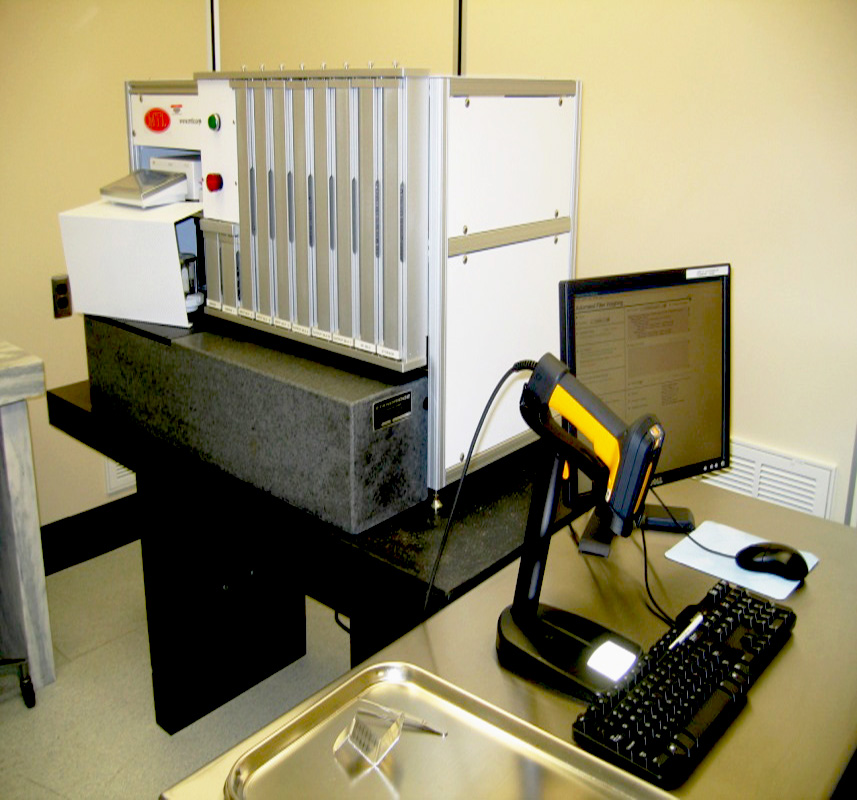Purpose
The AIR QUALITY SECTION provides analytical and technical services in the evaluation of air quality in Maryland. The section is comprised of two laboratory units: Bulk Asbestos Laboratory and the PM 2.5 Filter Weighing Laboratory
The Bulk Asbestos Laboratory, analyses building materials for asbestos fibers which are harmful to our health as they are known to be carcinogenic causing lung disease such as mesothelioma. Samples are prepared and examined under polarized light microscopy for common and uncommon types of abestos. Common types of asbestos are amosite, chrysotile, crocidolite. Uncommon asbestos are anthophylite, tremolite and actinolite.
The PM 2.5 Filter Weighing Laboratory utilizes a MTL Automatic System for the measurement of particulate matter. The filters are pre-weighed, sent into the field and placed in sampling pumps that collect particle sizes equal to or less than 2.5 microns in ambient air for a minimum of 24 hours. To summarize these pre-weighed filters have been conditioned (72-96 hours) in a controlled environment, sent to the field, sampled, returned, reconditioned in the clean room and then post-weighed. The difference is calculated and reported to the customer as total dust. Particle size collection and weighing is a detrimental part of air monitoring and is in support of the Clean Air Act. PM 2.5 contributes to the high incidences of asthma and lung disease as well as other respiratory illnesses; such as chronic bronchitis. It comes from primarily vehicle exhausts and fuel burning operations.
Samples for this section are analyzed in support of programs such as Maryland Department of Environment (MDE), Maryland National Guard, Maryland State agencies and local governments. Federal laws/policy such as NESHAP and AHERA are supported by the laboratory. The Bulk Asbestos lab is NVLAP accredited and the PM 2.5 Filter Weighing laboratory is EPA certified.
Instrumentation
Bulk Asbestos
- Trinocular microscope (PLM with PAXCAM camera) with PAXIT software
Biohazard hood of Class II with a HEPA filter
Stereo-microscope with 10 – 45X magnification and light source
Abbe Refractometer
Polarized Light Microscope With Camera
The stereoscope and the polarized light microscope (PLM) are used in the analysis of Bulk Asbestos. The sample is first examined by the analyst using the Stereoscope and it is then further prepared and examined based on the initial examine. A camera is attached to the PLM to take photographs of chain of custody sample that may be used in the court of law.
PM 2.5 Filter Weighing
- Environmentally controlled balance room
- Microbalance
- MTL automated system with Filter Weighing System Software
-
Marble balance table
MTL Filtering Weighting System
 PM 2.5 analysis is performed using a automated Measurement Technology Laboratory (MTL) Instrument. The microbalance has a readability of 0.001 mg (1µg) and a repeatability of ±1µg. The operation is delicate as the samples must be handled carefully to avoid loss of sample and to reduce electrostatic charge build up as these elements can cause inaccurate readings. The lab maintains a controlled environment by continually monitoring the temperature and humidity of the balance room, daily cleaning, and utilization of antistatic lab coats, gloves, wipes, ionizing blowers, tacky mats, and polonium strip.
PM 2.5 analysis is performed using a automated Measurement Technology Laboratory (MTL) Instrument. The microbalance has a readability of 0.001 mg (1µg) and a repeatability of ±1µg. The operation is delicate as the samples must be handled carefully to avoid loss of sample and to reduce electrostatic charge build up as these elements can cause inaccurate readings. The lab maintains a controlled environment by continually monitoring the temperature and humidity of the balance room, daily cleaning, and utilization of antistatic lab coats, gloves, wipes, ionizing blowers, tacky mats, and polonium strip.
Elements Routinely Analyzed
This section performs analysis of the measurement of respirable dust on PM2.5 filters and the analysis of bulk asbestos in building materials and airborne particulate such as soot, coal dust, grain dust, pollen, kish, etc.
NA = not applicable * from pre-sampling weight to final exposed weight. Exposed filters unrefrigerated are stable for 10 days
Potential Health Concerns and Environmental Effects
People with heart or lung diseases, senior adults and young children are most often affected by pollution exposure. With highly elevated levels of particle pollution the healthiest of people can experience temporary symptoms from exposure.
Exposure to asbestos increases your risk of developing lung disease. Exposure to airborne friable asbestos may result in a potential health risk because persons breathing the air may breathe in asbestos fibers. Continued exposure can increase the amount of fibers that remain in the lung. Fibers embedded in lung tissue over time may cause serious lung diseases including asbestosis, lung cancer, or mesothelioma.
Fine particles (PM2.5) are the main cause of reduced visibility (haze) in parts of the United States, including many of our treasured national parks and wilderness areas. Particles can be carried over long distances by wind and then settle on ground or water. The effects of this settling include: making lakes and streams acidic; changing the nutrient balance in coastal waters and large river basins; depleting the nutrients in soil; damaging sensitive forests and farm crops; and affecting the diversity of ecosyste.

